Abstract
It has been postulated that alterations in the intravascular distribution of blood affect antidiuretic hormone (ADH) secretion in man. The studies reported here were designed to alter blood distribution by thermal and by positional change to test this thesis.
Human blood ADH levels have been shown to vary with position: a mean value of 0.4 ± 0.6 (SD) μU/ml was obtained while the subject was supine, a value of 1.4 ± 0.7 μU/ml while sitting, and 3.1 ± 1.5 μU/ml while standing. In 79 control subjects, sitting comfortably for 30 min in a normal environment, a blood ADH level of 1.65 ± 0.63 μU/ml was found. It is suggested that subjects assume this position during experiments in which blood is drawn for measurement of ADH levels.
In eight seated subjects the ADH level rose from 1.6 ± 0.4 to 5.2 ± 0.8 μU/ml after a 2 hr exposure at 50°C and fell to 1.0 ± 0.26 μU/ml within 15 min at 26°C.
Six subjects with a mean ADH level of 2.2 ± 0.58 μU/ml sat quietly in the cold (13°C) for 1 hr, and the ADH level fell to 1.2 ± 0.36 μU/ml. After 15 min at 26°C, the level rose to 3.1 ± 0.78 μU/ml. The serum sodium and osmolal concentrations remained constant during all studies.
Water, sodium, and total solute excretion decreased during exposure to the heat, whereas the urine to plasma (U/P) osmolal ratio increased. During cold exposure, water, sodium, and total solute excretion increased, and there was a decrease in the U/P osmolal ratio.
These data are interpreted as indicating that changes in activity of intrathoracic stretch receptors, in response to redistribution of blood, alter ADH secretion independently of changes in serum osmolality. The rapidity of change of blood ADH concentration indicates a great sensitivity and a prime functional role for the “volume receptors” in the regulation of ADH secretion.
Full text
PDF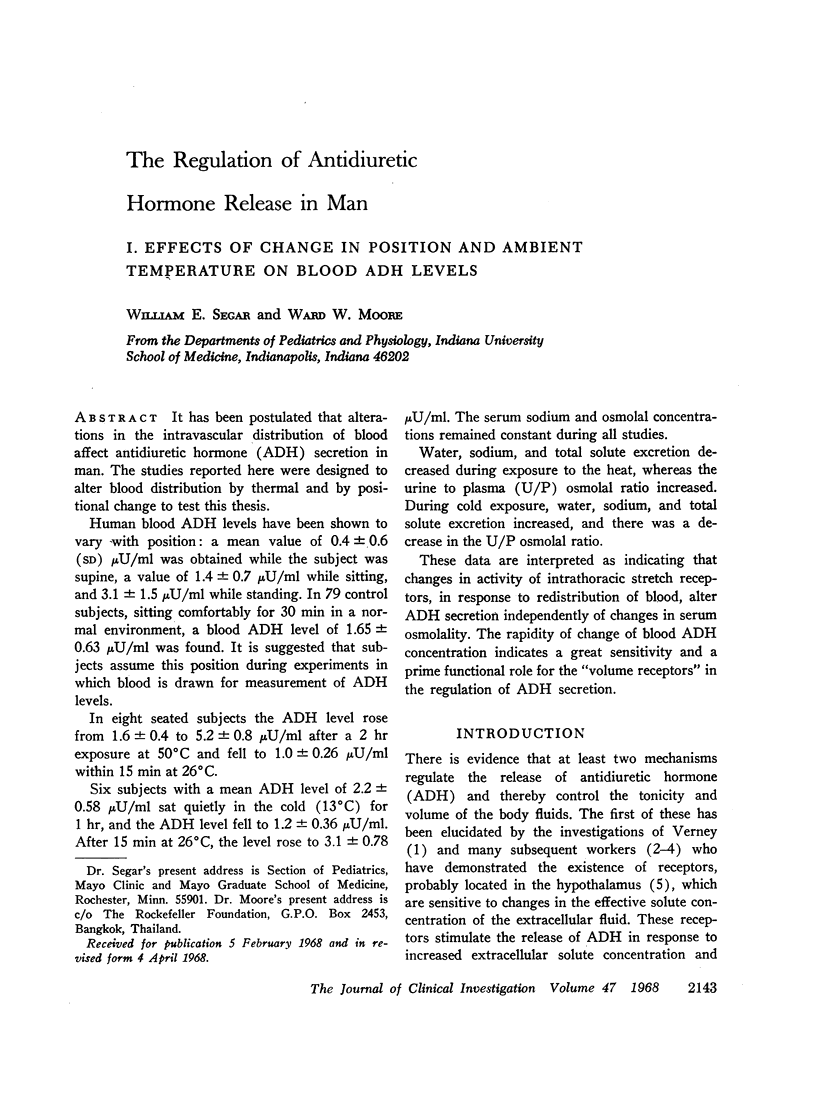
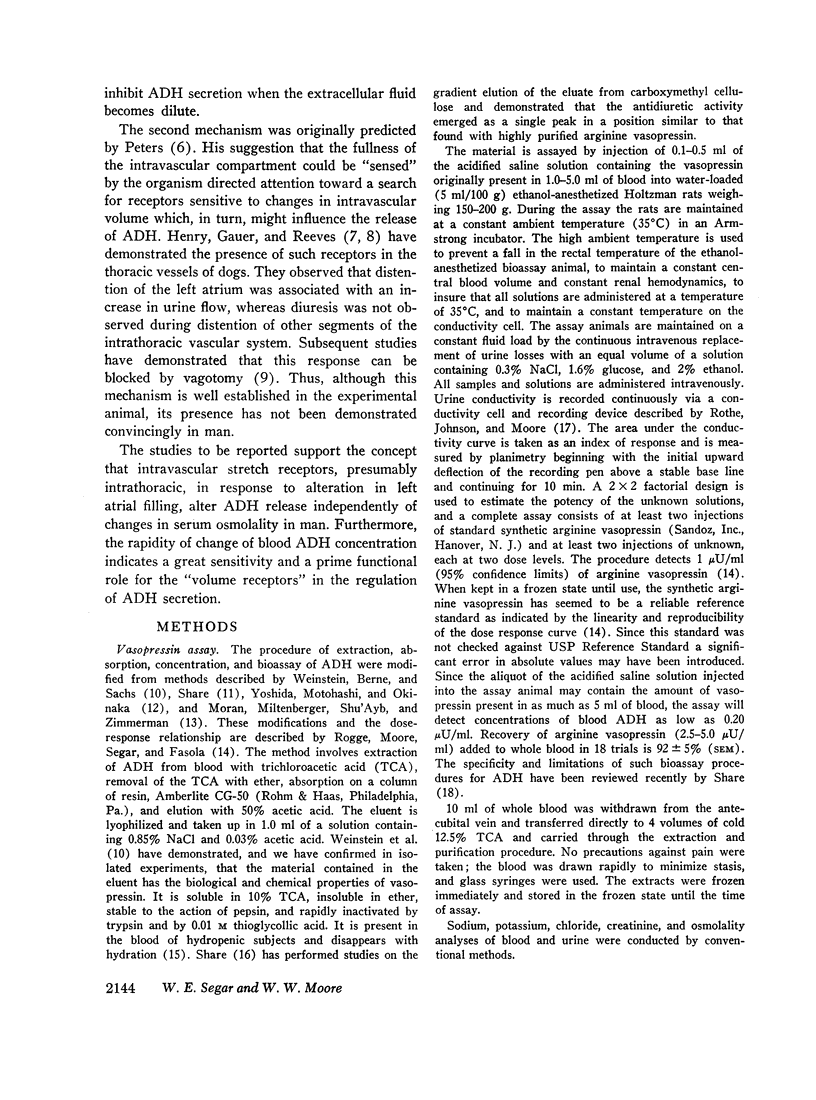
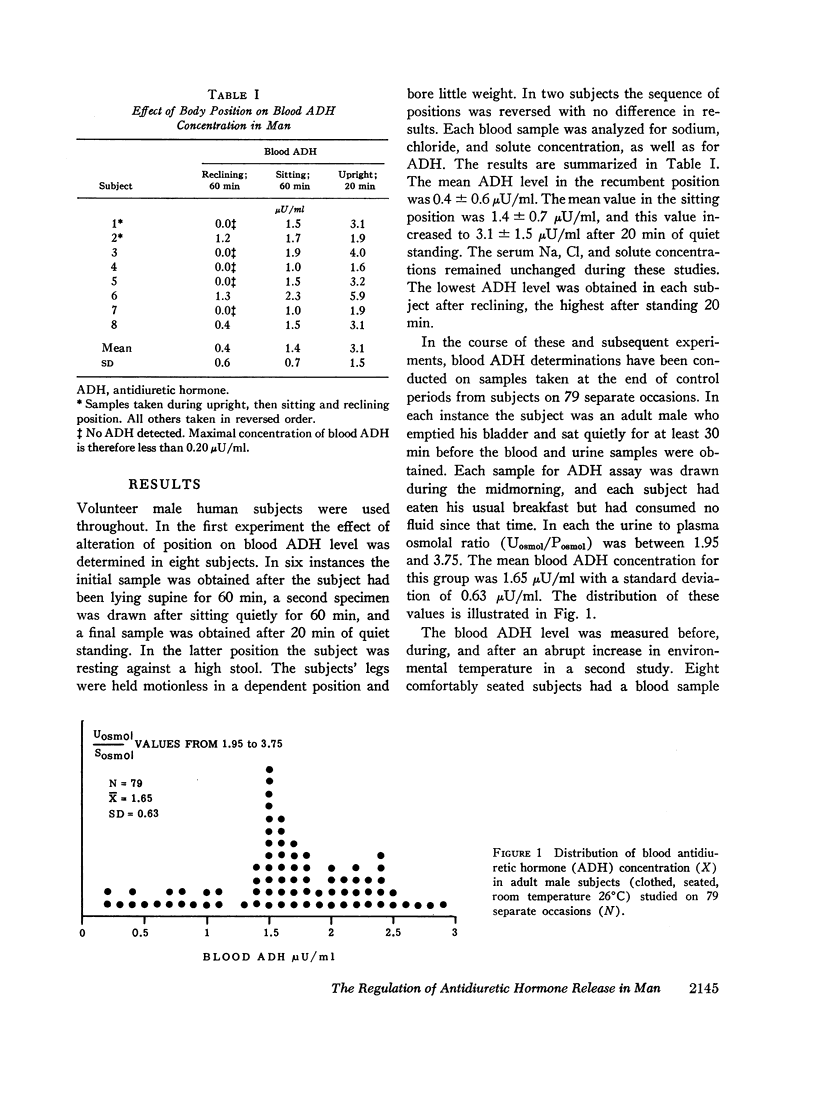
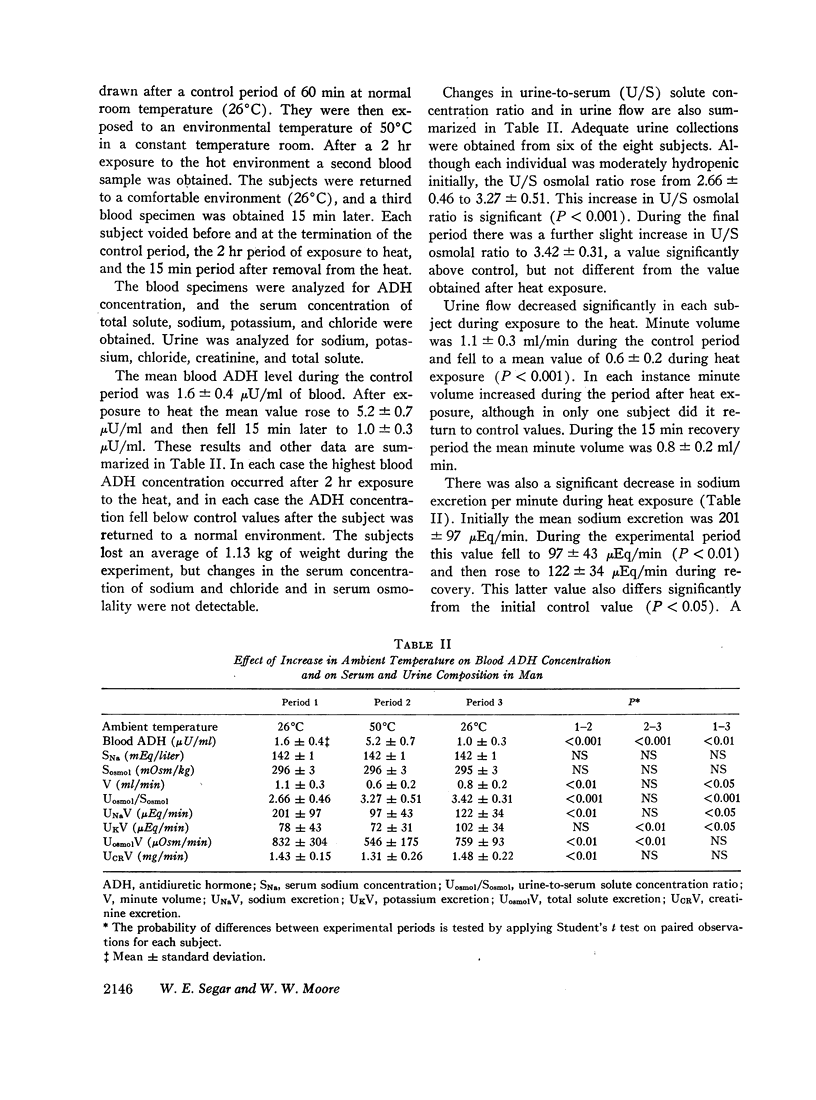
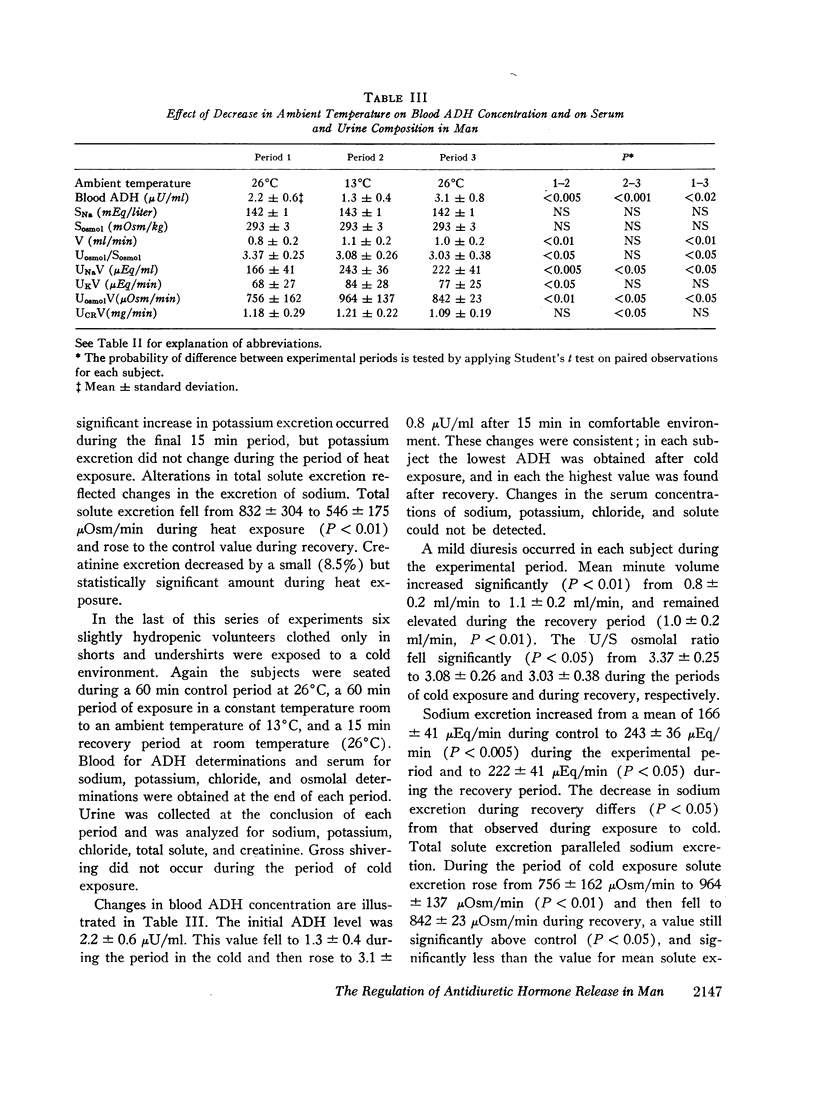
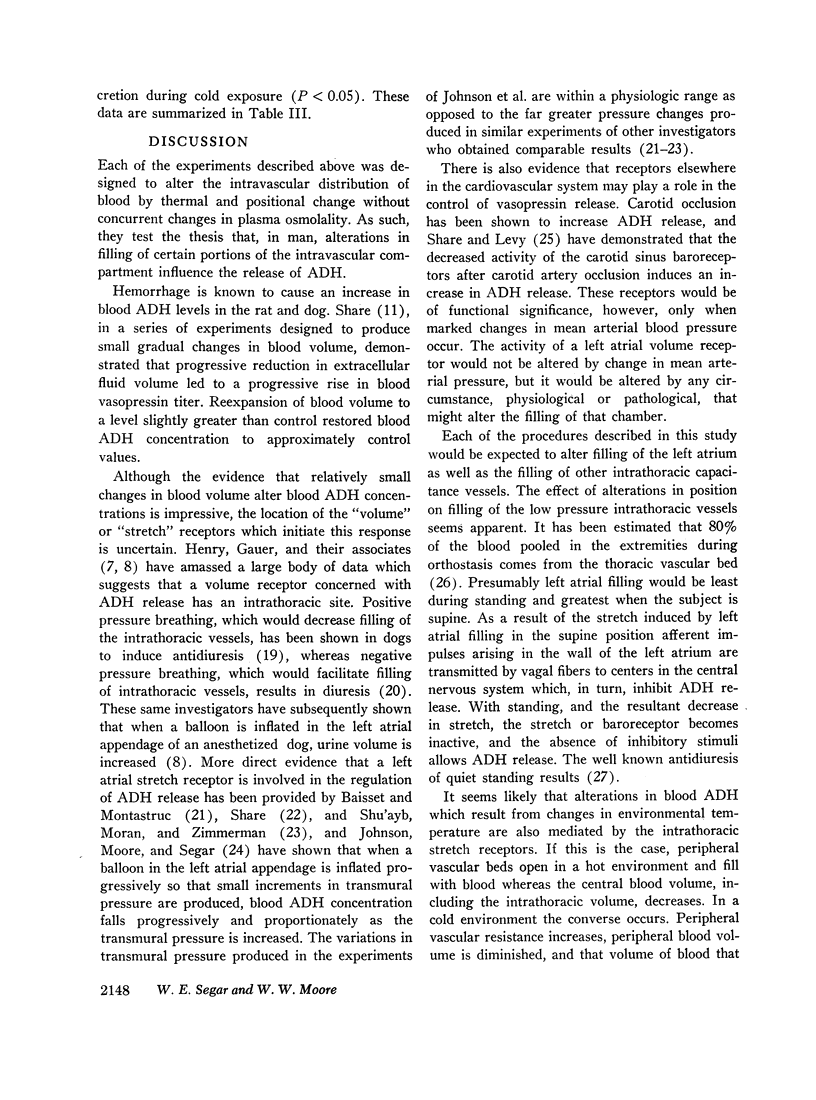
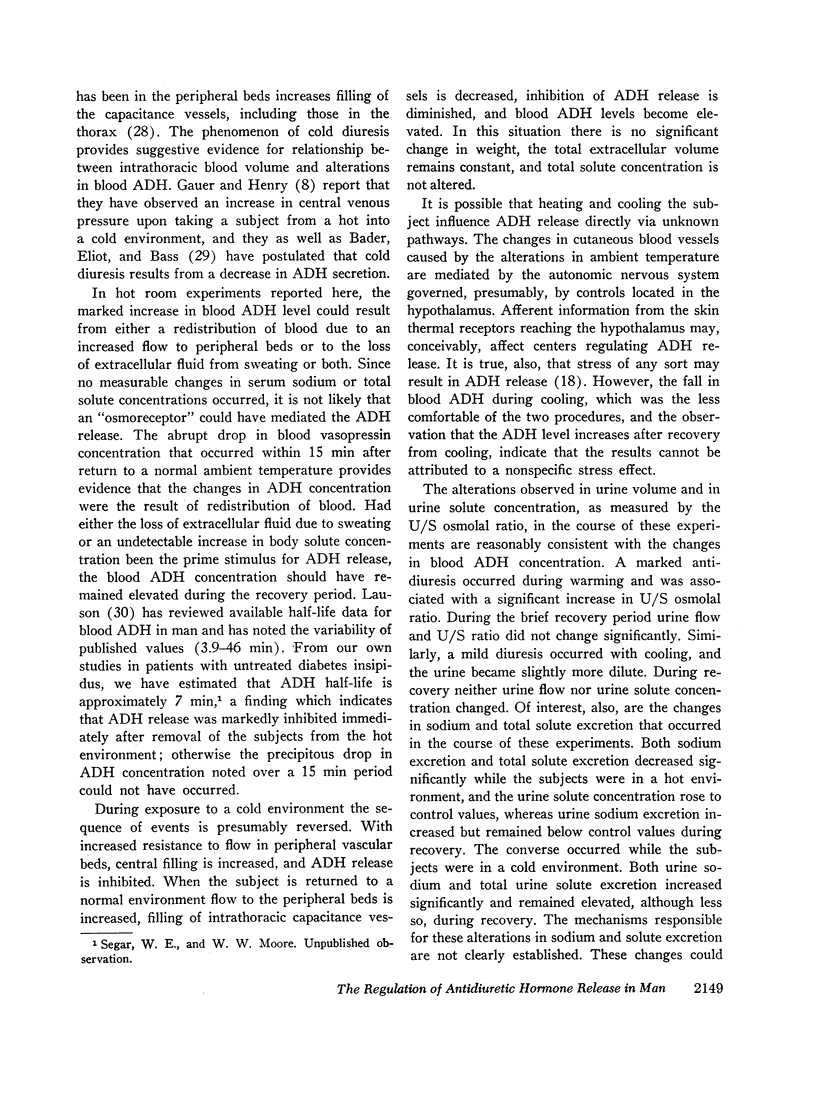
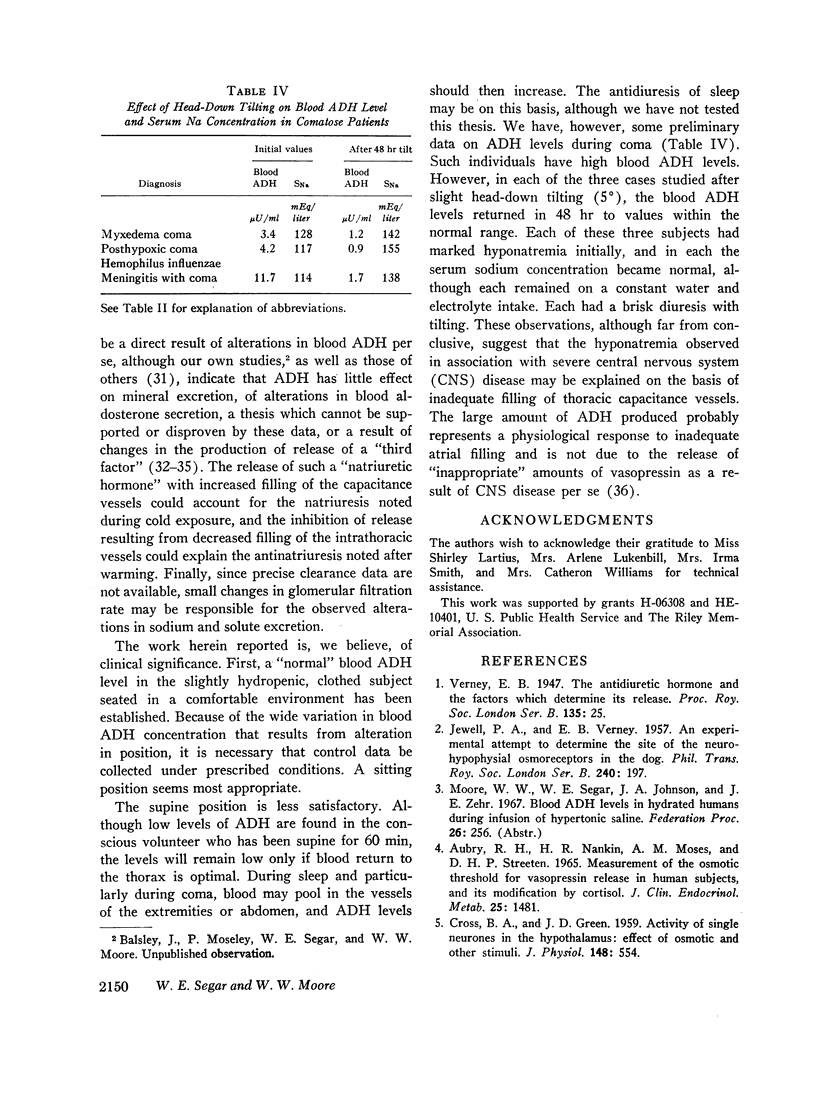
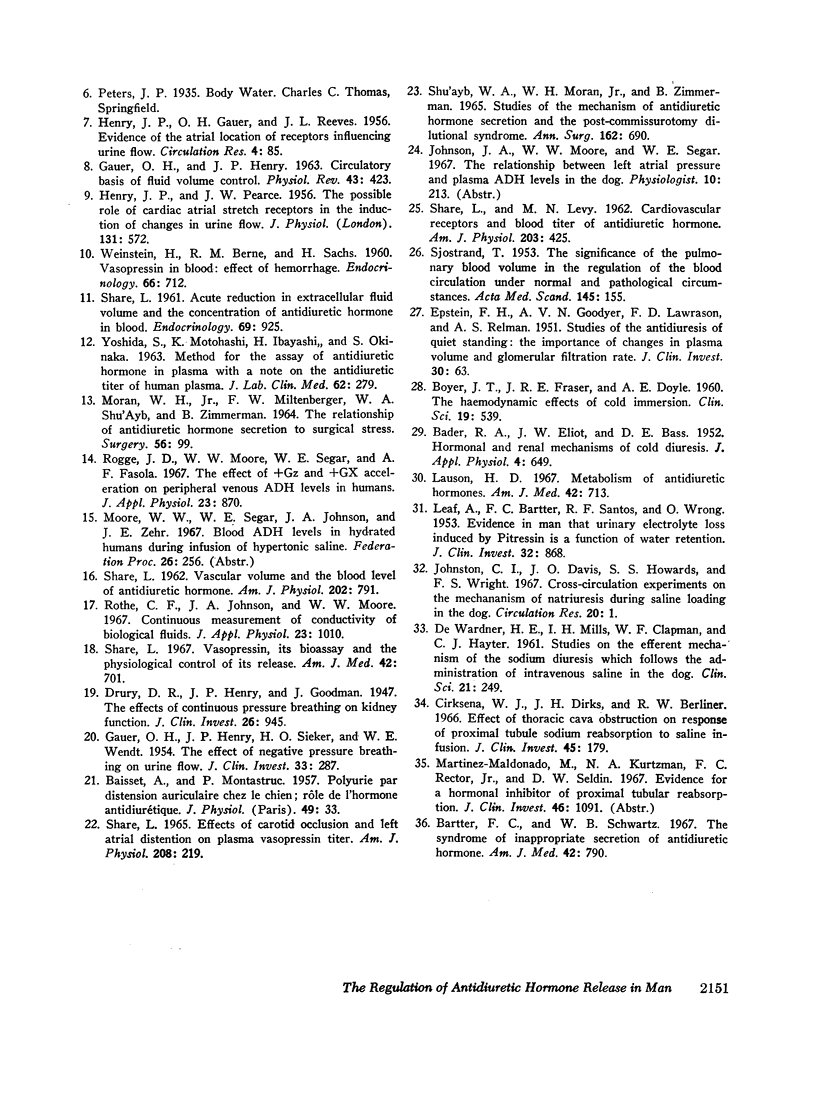
Selected References
These references are in PubMed. This may not be the complete list of references from this article.
- Aubry R. H., Nankin H. R., Moses A. M., Streeten D. H. Measurement of the osmotic threshold for vasopressin release in human subjects, and its modification by cortisol. J Clin Endocrinol Metab. 1965 Nov;25(11):1481–1492. doi: 10.1210/jcem-25-11-1481. [DOI] [PubMed] [Google Scholar]
- BADER R. A., ELIOT J. W., BASS D. E. Hormonal and renal mechanisms of cold diuresis. J Appl Physiol. 1952 Feb;4(8):649–658. doi: 10.1152/jappl.1952.4.8.649. [DOI] [PubMed] [Google Scholar]
- Bartter F. C., Schwartz W. B. The syndrome of inappropriate secretion of antidiuretic hormone. Am J Med. 1967 May;42(5):790–806. doi: 10.1016/0002-9343(67)90096-4. [DOI] [PubMed] [Google Scholar]
- CROSS B. A., GREEN J. D. Activity of single neurones in the hypothalamus: effect of osmotic and other stimuli. J Physiol. 1959 Oct;148:554–569. doi: 10.1113/jphysiol.1959.sp006306. [DOI] [PMC free article] [PubMed] [Google Scholar]
- Cirksena W. J., Dirks J. H., Berliner R. W. Effect of thoracic cava obstruction on response of proximal tubule sodium reabsorption to saline infusion. J Clin Invest. 1966 Feb;45(2):179–186. doi: 10.1172/JCI105330. [DOI] [PMC free article] [PubMed] [Google Scholar]
- DE WARDENER H. E., MILLS I. H., CLAPHAM W. F., HAYTER C. J. Studies on the efferent mechanism of the sodium diuresis which follows the administration of intravenous saline in the dog. Clin Sci. 1961 Oct;21:249–258. [PubMed] [Google Scholar]
- Drury D. R., Henry J. P., Goodman J. THE EFFECTS OF CONTINUOUS PRESSURE BREATHING ON KIDNEY FUNCTION. J Clin Invest. 1947 Sep;26(5):945–951. doi: 10.1172/JCI101889. [DOI] [PMC free article] [PubMed] [Google Scholar]
- EPSTEIN F. H., GOODYER A. V. N., LAWRASON F. D., RELMAN A. S. Studies of the antidiuresis of quiet standing: the importance of changes in plasma volume and glomerular filtration rate. J Clin Invest. 1951 Jan;30(1):63–72. doi: 10.1172/JCI102417. [DOI] [PMC free article] [PubMed] [Google Scholar]
- GAUER O. H., HENRY J. P. Circulatory basis of fluid volume control. Physiol Rev. 1963 Jul;43:423–481. doi: 10.1152/physrev.1963.43.3.423. [DOI] [PubMed] [Google Scholar]
- GAUER O. H., HENRY J. P., SIEKER H. O., WENDT W. E. The effect of negative pressure breathing on urine flow. J Clin Invest. 1954 Feb;33(2):287–296. doi: 10.1172/JCI102897. [DOI] [PMC free article] [PubMed] [Google Scholar]
- HENRY J. P., GAUER O. H., REEVES J. L. Evidence of the atrial location of receptors influencing urine flow. Circ Res. 1956 Jan;4(1):85–90. doi: 10.1161/01.res.4.1.85. [DOI] [PubMed] [Google Scholar]
- HENRY J. P., PEARCE J. W. The possible role of cardiac atrial stretch receptors in the induction of changes in urine flow. J Physiol. 1956 Mar 28;131(3):572–585. doi: 10.1113/jphysiol.1956.sp005483. [DOI] [PMC free article] [PubMed] [Google Scholar]
- Johnston C. I., Davis J. O., Howards S. S., Wright F. S. Cross-circulation experiments on the mechanism of the natriuresis during saline loading in the dog. Circ Res. 1967 Jan;20(1):1–10. doi: 10.1161/01.res.20.1.1. [DOI] [PubMed] [Google Scholar]
- LEAF A., BARTTER F. C., SANTOS R. F., WRONG O. Evidence in man that urinary electrolyte loss induced by pitressin is a function of water retention. J Clin Invest. 1953 Sep;32(9):868–878. doi: 10.1172/JCI102805. [DOI] [PMC free article] [PubMed] [Google Scholar]
- Lauson H. D. Metabolism of antidiuretic hormones. Am J Med. 1967 May;42(5):713–744. doi: 10.1016/0002-9343(67)90091-5. [DOI] [PubMed] [Google Scholar]
- Rogge J. D., Moore W. W., Segar W. E., Fasola A. F. Effect of +Gz and +Gx acceleration on peripheral venous ADH levels in humans. J Appl Physiol. 1967 Dec;23(6):870–874. doi: 10.1152/jappl.1967.23.6.870. [DOI] [PubMed] [Google Scholar]
- Rothe C. F., Johnson J. A., Moore W. W. Continuous measurement of conductivity of biological fluids. J Appl Physiol. 1967 Dec;23(6):1010–1013. doi: 10.1152/jappl.1967.23.6.1010. [DOI] [PubMed] [Google Scholar]
- SHARE L. Acute reduction in extracellular fluid volume and the concentration of antidiuretic hormone in blood. Endocrinology. 1961 Nov;69:925–933. doi: 10.1210/endo-69-5-925. [DOI] [PubMed] [Google Scholar]
- SHARE L. EFFECTS OF CAROTID OCCLUSION AND LEFT ATRIAL DISTENTION ON PLASMA VASOPRESSIN TITER. Am J Physiol. 1965 Feb;208:219–223. doi: 10.1152/ajplegacy.1965.208.2.219. [DOI] [PubMed] [Google Scholar]
- SHARE L., LEVY M. N. Cardiovascular receptors and blood titer of antidiuretic hormone. Am J Physiol. 1962 Sep;203:425–428. doi: 10.1152/ajplegacy.1962.203.3.425. [DOI] [PubMed] [Google Scholar]
- SHARE L. Vascular volume and blood level of antidiuretic hormone. Am J Physiol. 1962 Apr;202:791–794. doi: 10.1152/ajplegacy.1962.202.4.791. [DOI] [PubMed] [Google Scholar]
- SJOSTRAND T. The significance of the pulmonary blood volume in the regulation of the blood circulation under normal and pathological conditions. Acta Med Scand. 1953;145(3):155–168. [PubMed] [Google Scholar]
- Share L. Vasopressin, its bioassay and the physiological control of its release. Am J Med. 1967 May;42(5):701–712. doi: 10.1016/0002-9343(67)90090-3. [DOI] [PubMed] [Google Scholar]
- Shu'ayb W. A., Moran W. H., Jr, Zimmermann B. Studies of the mechanism of antidiuretic hormone secretion and the post-commissurotomy dilutional syndrome. Ann Surg. 1965 Oct;162(4):690–701. doi: 10.1097/00000658-196510000-00012. [DOI] [PMC free article] [PubMed] [Google Scholar]
- VERNEY E. B. The antidiuretic hormone and the factors which determine its release. Proc R Soc Lond B Biol Sci. 1947 Dec 16;135(878):25–106. [PubMed] [Google Scholar]
- WEINSTEIN H., BERNE R. M., SACHS H. Vasopressin in blood: effect of hemorrhage. Endocrinology. 1960 May;66:712–718. doi: 10.1210/endo-66-5-712. [DOI] [PubMed] [Google Scholar]
- YOSHIDA S., MOTOHASHI K., IBAYASHI H., OKINAKA S. METHOD FOR THE ASSAY OF ANTIDIURETIC HORMONE IN PLASMA WITH A NOTE ON THE ANTIDIURETIC TITER OF HUMAN PLASMA. J Lab Clin Med. 1963 Aug;62:279–285. [PubMed] [Google Scholar]


